When buying a knife, there are hundreds of features, options and styles to choose from. Specifically, if you’re getting a folding knife, there’s the issue of selecting the type of locking system fits your needs and preferences best. Locking systems are essential for folding knives because they prevent the knife from closing on your hand during use. Instead of having to frantically search around the web to learn about all the different types, here’s a comprehensive list of the locking systems used in most folding knives.
Liner Lock
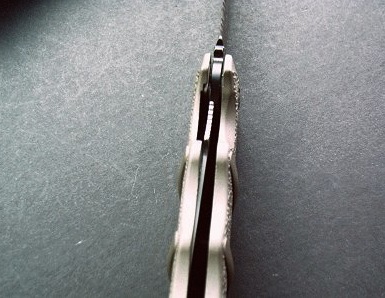 The liner lock, originally known as a Walker Lock after its inventor Michael Walker, is one of the most popular types of locking systems. When the knife blade is opened, a vertical metal lockbar is angled from the side of the interior toward the center where it butts against the tang of the blade. The pressure of the lockbar, also called a leaf spring, prevents the blade from moving. To fold the blade back into the knife, the lockbar has to be moved away from the tang to its original position.
The liner lock, originally known as a Walker Lock after its inventor Michael Walker, is one of the most popular types of locking systems. When the knife blade is opened, a vertical metal lockbar is angled from the side of the interior toward the center where it butts against the tang of the blade. The pressure of the lockbar, also called a leaf spring, prevents the blade from moving. To fold the blade back into the knife, the lockbar has to be moved away from the tang to its original position.
Lockback
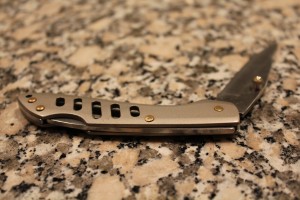 A lockback is sometimes called a spine lock because it has a metal spin that spans the entire back of the knife handle. Within the handle, the top of the spine and the tang of the blade resembles a hook. When the blade is opened, it pushes the spine out until the notch on the spine and blade are hooked into place. The two notches exert pressure on one another to keep the blade opened securely. Replacing the blade into the handle of a lockback knife requires pressing on the bottom of the spine until the two notches clear one another.
A lockback is sometimes called a spine lock because it has a metal spin that spans the entire back of the knife handle. Within the handle, the top of the spine and the tang of the blade resembles a hook. When the blade is opened, it pushes the spine out until the notch on the spine and blade are hooked into place. The two notches exert pressure on one another to keep the blade opened securely. Replacing the blade into the handle of a lockback knife requires pressing on the bottom of the spine until the two notches clear one another.
Frame Lock
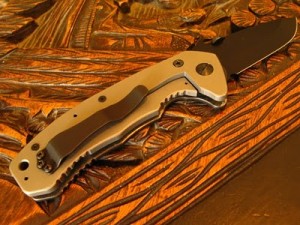 The frame lock is a similar concept to the liner lock, but instead of a separate metal liner within the interior of the handle, the knife’s frame is the actual lock. The frame, which is created similar to the lockbar, positions itself beneath the tang of the blade when it’s opened, so it can’t fold. Closing the blade requires the frame to be pushed back to its original position.
The frame lock is a similar concept to the liner lock, but instead of a separate metal liner within the interior of the handle, the knife’s frame is the actual lock. The frame, which is created similar to the lockbar, positions itself beneath the tang of the blade when it’s opened, so it can’t fold. Closing the blade requires the frame to be pushed back to its original position.
Lever Lock
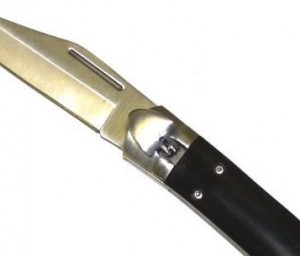 The main component of the lever lock is a pin that prevents the blade from closing. When the blade is opened completely, the pin from the handle fits snugly into a hole in the tang of blade. Once a lever attached to the knife is pushed down, it lifts the pin out of the tang of the blade, so it can close. Likewise, the pin holds the blade closed, so you also have to press the lever down in order to engage it.
The main component of the lever lock is a pin that prevents the blade from closing. When the blade is opened completely, the pin from the handle fits snugly into a hole in the tang of blade. Once a lever attached to the knife is pushed down, it lifts the pin out of the tang of the blade, so it can close. Likewise, the pin holds the blade closed, so you also have to press the lever down in order to engage it.
Clasp Lock
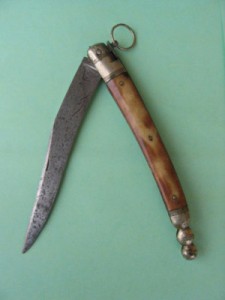 A clasp locking system uses a piece of strong metal at the top rear of the handle. When the knife is opened, a post inserts itself into that piece of metal similar to a plunge lock. To disengaged the knife, you push up on a clasp so it lifts the piece of metal until the post clears its hole. Sometimes the clasp is a simple metal ring that you pull.
A clasp locking system uses a piece of strong metal at the top rear of the handle. When the knife is opened, a post inserts itself into that piece of metal similar to a plunge lock. To disengaged the knife, you push up on a clasp so it lifts the piece of metal until the post clears its hole. Sometimes the clasp is a simple metal ring that you pull.
Mid Lock
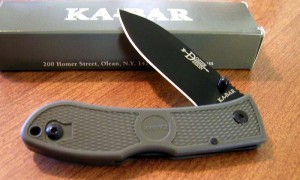 The mid lock is essentially the same thing as a lockback locking system except the release for the lock is located in the middle of the handle rather than the bottom. If you look at the spine of one of these knives, you’ll notice it doesn’t extend all the way to the bottom of the handle. The reason it’s in the middle is because the shorter spine can withstand more pressure.
The mid lock is essentially the same thing as a lockback locking system except the release for the lock is located in the middle of the handle rather than the bottom. If you look at the spine of one of these knives, you’ll notice it doesn’t extend all the way to the bottom of the handle. The reason it’s in the middle is because the shorter spine can withstand more pressure.
Ring Lock
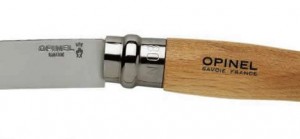 Sometimes known as a collar lock, the ring lock requires you to twist a ring at the top of the knife’s handle to open and close it. This type is found mostly on Opinel knives. You essentially twist the ring until the blade aligns with the vertical slot, so it can open it. Then to lock it in place, you twist the vertical slot away from the blade.
Sometimes known as a collar lock, the ring lock requires you to twist a ring at the top of the knife’s handle to open and close it. This type is found mostly on Opinel knives. You essentially twist the ring until the blade aligns with the vertical slot, so it can open it. Then to lock it in place, you twist the vertical slot away from the blade.
Slip Joint
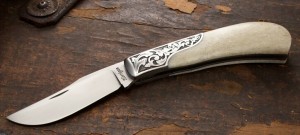 Although it doesn’t necessarily lock the blade in place, the slip joint uses pressure from a spring to hold the blade up. It will close when you apply a specific amount of pressure, which is why the slip joint is seen mostly on light duty pocket knives.
Although it doesn’t necessarily lock the blade in place, the slip joint uses pressure from a spring to hold the blade up. It will close when you apply a specific amount of pressure, which is why the slip joint is seen mostly on light duty pocket knives.
Brand Specific Locking Systems
AXIS Lock
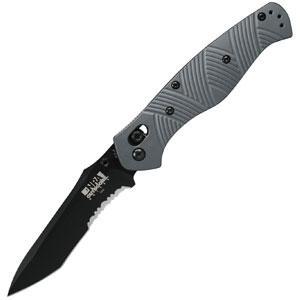 Benchmade Knives designed what they call the AXIS locking system. In this system, there is a small bar that spans the width of the handle. When the blade is opened, the bar is pushed forward within its slot until it locks into place when the blade is fully extended. The bar rests on top of the tang of the blade, so it can’t close.
Benchmade Knives designed what they call the AXIS locking system. In this system, there is a small bar that spans the width of the handle. When the blade is opened, the bar is pushed forward within its slot until it locks into place when the blade is fully extended. The bar rests on top of the tang of the blade, so it can’t close.
Arc Lock
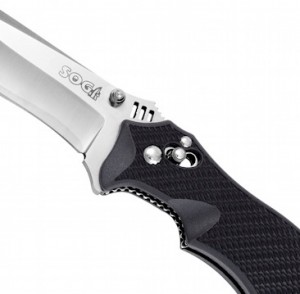 This lock is only found in SOG Specialty Knives and is remarkably similar to the AXIS lock. However, instead of a bar that moves in a vertical motion, the arc lock has a device that moves in an arc. Overall, the bar and arc device both function identically and block the tang of the blade from closing when engaged.
This lock is only found in SOG Specialty Knives and is remarkably similar to the AXIS lock. However, instead of a bar that moves in a vertical motion, the arc lock has a device that moves in an arc. Overall, the bar and arc device both function identically and block the tang of the blade from closing when engaged.
Tri-Ad Lock
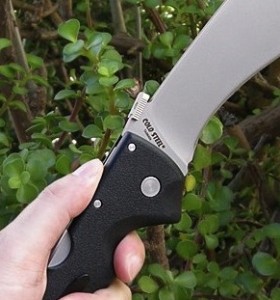 The Tri-Ad locking system is exclusively licensed to Cold Steel. It resembles the lockback in that the tang of the blade fits into a notch along the spine, but there is a patented “stop pin” that redistributes the pressure from the lock to the spine for additional strength.
The Tri-Ad locking system is exclusively licensed to Cold Steel. It resembles the lockback in that the tang of the blade fits into a notch along the spine, but there is a patented “stop pin” that redistributes the pressure from the lock to the spine for additional strength.




December 28, 2016 at 9:43 pm
Thank you for the information, it was helpful. Watched my dad make a knife using a diamond blade from a chop saw, years back. I am going to do my best to make my first knive this week. I made a bevel jig I watched saw online, and have been reading and watching videos. If you have any helpful tips, iam all ears. Making my blade from a 11/4″ x 6 1/2″ x 3/8″ to 1/8″ pc of surgical steel we picked up from L.S.U. medical school in New Orleans, after Katrina. Have about 7 pcs different sizes, its been something i have wanted to do for years know but never had time. next is handle making, by the way its going to be a fixed blade straight razor style blade. wish me luck for a good looking outcome.
regards,
D.M. Fletcher
February 9, 2017 at 7:02 pm
Blade lock, slide lock, lever lock???
April 12, 2018 at 7:37 am
Great resourse for the knife addicts. I’ve bookmarked it.
November 29, 2018 at 1:47 am
I just want to point out that Michael Walker didn’t invent the liner lock at all! It is, like most lock types, a very old solution and can be found on knives from the 1900 century. What he did was adding a “detent ball” to the solution and thus modernized it. Quite a difference! 🙂
November 29, 2018 at 4:27 am
Hey John. I agree that Walker didn’t truly invent the liner lock, though his design is very different than those older liner locks. Some even believe that they are so different that they represent different lock types. It’s on my to-do list to do a deep dive into the history and functionality of the liner lock.
December 19, 2018 at 8:47 pm
Question please. I have a lock blade, where the lock release is part(maybe) of the joint itself. Has mark stamped on blade O with a crown, a knife thru the O, and USA under. Any ideas?
February 12, 2019 at 12:10 am
This is probably a Queen Steel product. Queen steel knifes are a high quality american product. My first pocket knife was a Queen Steel stockman folder and my dad carried one for many years. I am not positive but I don’t think they are in production any longer,but I could be wrong.
February 12, 2019 at 9:38 am
Yup. Definitely sounds like a knife from Queen Cutlery. Unfortunately, the company went out of business in early 2018. I don’t know which model has the locking blade in the joint though.